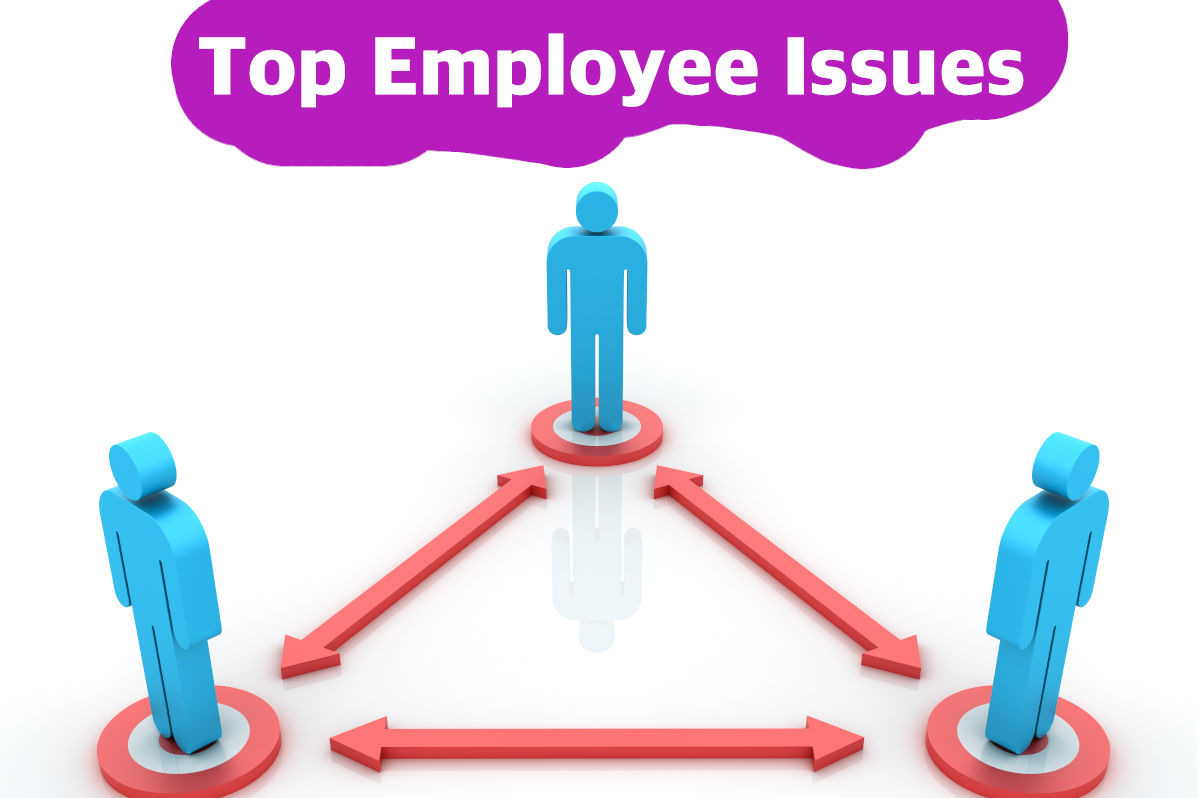In my previous article “What is the role of human resources?” I spoke about the Path of Feedback. This article is a general feedback from me a human resource professional, about the top employee issues that I have experienced.
The top employee issues are employees are always late, calling in sick, starting late and ending early, having low performance, not getting along, not doing as instructed, don’t participate in meetings, and keep quitting.
Read below for more details on each issue above.
Employees Are Always Late
Employees are always or consistently late because they don’t respect the job or they have more important life issues they’re dealing with. An employer’s first instinct is to start tracking each late event and start the disciplinary process leading to dismissal.
Negatives
Highlighting the negatives creates a negative work environment. Ultimately this leads to more employees being late as they also lose respect for the job and organization.
If the employee has a lot of personal issues going on you need to create a work environment that is positive. There may be additional factors like proper pay and benefits that may encourage more respect. This will allow them to see work as an escape from life.
Positives
Consider highlighting the positives. Reward employees that are consistently on time. This will create a positive work environment where people doing good get the reward. It may take time to change things in the work environment. The longer a positive program like this is around the more the employees will respect and trust the organization.
Good Emplyee Turnover
The added benefit of a positive work environment is that lazy workers or low performers will leave on their own. No one wants to be the worst performer in a high-performing organization. This is a good thing for the organization and a good thing for the departing employee. Now they can find a job or role they really like and are good at.
Employees Are Calling in Sick
A single employee consistently calling in sick may be an issue with just that employee. Multiple employees consistently calling in sick may mean an issue with the organization.
Personal Stress
Employees have different lives but we all sometimes have times of high personal stress. These times of stress may be a few weeks, months, or even years. Even your best employees or top performers may go through this phase of life. Supporting them through this phase may be better than punishment or decreased support.
Proper pay, good benefits, more vacation time, and more sick or personal days can help. These sorts of things may have an organization-wide positive benefit reducing the possibility that more employees will start calling in sick.
Multiple Employees Sick
In the event of multiple employees consistently calling in sick you have a major problem. Calling in sick is a symptom of an issue, not an issue. On the large scale, you need to investigate what is happening.
Consider having a series of employee engagement surveys done every three months for a year. After each survey, you will work on the top three issues before the next survey. After the first year, you should have a survey done every six months to prevent future issues from getting out of hand.
Employees Are Starting Late and Ending Early
Employees starting late and ending early can cost the organization production, revenue, and clients or customers. It is related to employees always being late. The employees do not respect the organization or have more important life issues going on.
Again, the natural first approach may be to punish this behaviour but that only fuels the negative work environment. You should take the positive approach because it is better for the long-term health of the work environment.
Get Creative
Reward the employees that start on time or work till the end. You can get creative with how you do this. An alternative is to start paying employees for an extra half hour a day to allow them to get prepared before the start of the shift. This will also allow them to work right to the end.
Staggering Shifts
Staggering shifts might help this situation also as now the employees will be covering each other at the start and end of each day. This allows you to pay the same amount and have your clients or customers needs to be handled.
Employees Have Low Performance
Employees low performance may be because they are having difficulty in their personal lives, have not had the proper training, don’t feel appreciated at work, or don’t see any career advancement opportunities.
We addressed personal issues above but in general, you need to make sure their basic employee needs are filled. This will hopefully improve the work environment so the employee can feel like being at work is less stressful than their personal lives.
More Training
Often employees are hired or promoted but they didn’t receive enough training in their new role. All employees need constant support and training opportunities to become top performers. Employees being considered for a promotion need special training as they move into senior roles that have more to do with people management.
Underappreciated Employees
Supervisors and managers may spend more time with problem employees than with regular (backbone) employees or top performers. This leads to regular or top performers feeling underappreciated. Why work hard all day when the manager spends no time acknowledging or rewarding hard work? You need to celebrate hard work so the squeaky wheels don’t get all the attention.
If there is no chance of career advancement, then employees will get complacent. Why should they work hard with no career advancement? Employees may begin to do just enough work to not get fired. Switching to a policy of promoting from within can help. Any good promotion from within policy needs a strong training component.
Employees Are Not Getting Along
Employees may not get along because roles are not properly defined, there is racism, or there is a negative work environment.
Properly Defined Roles
Roles must be properly defined so employees don’t get confused about their responsibility. Hand-off in workloads could get very confusing if not properly defined. If this is an issue you should review the related roles with the employees doing those roles. The input from the employees doing the work will be valuable in helping you make the final process.
Racism
Racism has been around for a long time and many people may not understand their level of privilege and unconscious bias. Organizational structures in the west are white supremacist in nature and are designed to protect white people. Everyone in your organization needs anti-racism training.
Additionally, our organization needs to give extra support to indigenous, black, and other people of colour. This is not “giving a leg up” it is working to make the playing field level for everyone.
Negative Work Envoironment
Above I wrote some about improving the work environment. There could be a million different reasons your organization’s work environment is negative. It’s time to get some feedback with employee engagement surveys as written above in the Employees Calling in Sick section.
Employees Are Not Doing as Instructed
Employees not doing as instructed could be because of a lack of training or maybe they don’t care about the job.
Lack of Training
It is very important to train employees properly and to continue training them. Some tasks may be hard to learn or remember on a busy day. Consider more training and helpful tools like daily lists or other creative options to support employees.
Not Caring
An employee that has lost interest in their role might be too late to save but try giving more support. It’s easy to give negative feedback and start the disciplinary process. The loss of a long-time employee could be hard on an organization so more support should be offered before dismissal.
Employees Don’t Participate in Meetings
Employees have been trained to keep quiet at meetings especially when managers or c-level leaders are in attendance. You must build an environment of trust and creativity. This can take a long time.
Make it part of the process to hear ideas or brainstorm ideas at every meeting. Eventually, employees will begin to trust the process and you can benefit from the hired brains in your organization.
Employees Keep Quitting
The two times you need to worry about employees quitting are if they’re regular (backbone) employees or top-performing employees. This is a bad turnover rate. If low performers are leaving, then that is a good turnover rate.
Regular employees are the backbone of your organization. They may not be top performers, but they are the people doing the bulk of the daily work in your organization. Top performers are generated through this group.
Top performers leaving is very bad. It may mean you have multiple or big issues with pay, benefits, and perks. You need to go back to the employee engagement survey to understand what the issues are, then work to fix them.
What Next?
You should track individual employee issues with simple frequent performance reviews. Also, investigate organization-wide issues with regular employee engagement surveys. Address issues right away with input from your hired brains.
For human resources support in Canada, click here to book a free HR needs assessment now. If you’re on a budget, consider joining my Patreon to ask unlimited HR questions. If you need HR advice sooner, book a consultation via Fiverr here.
HR questions. If you need HR advice sooner, book a consultation via Fiverr here.

